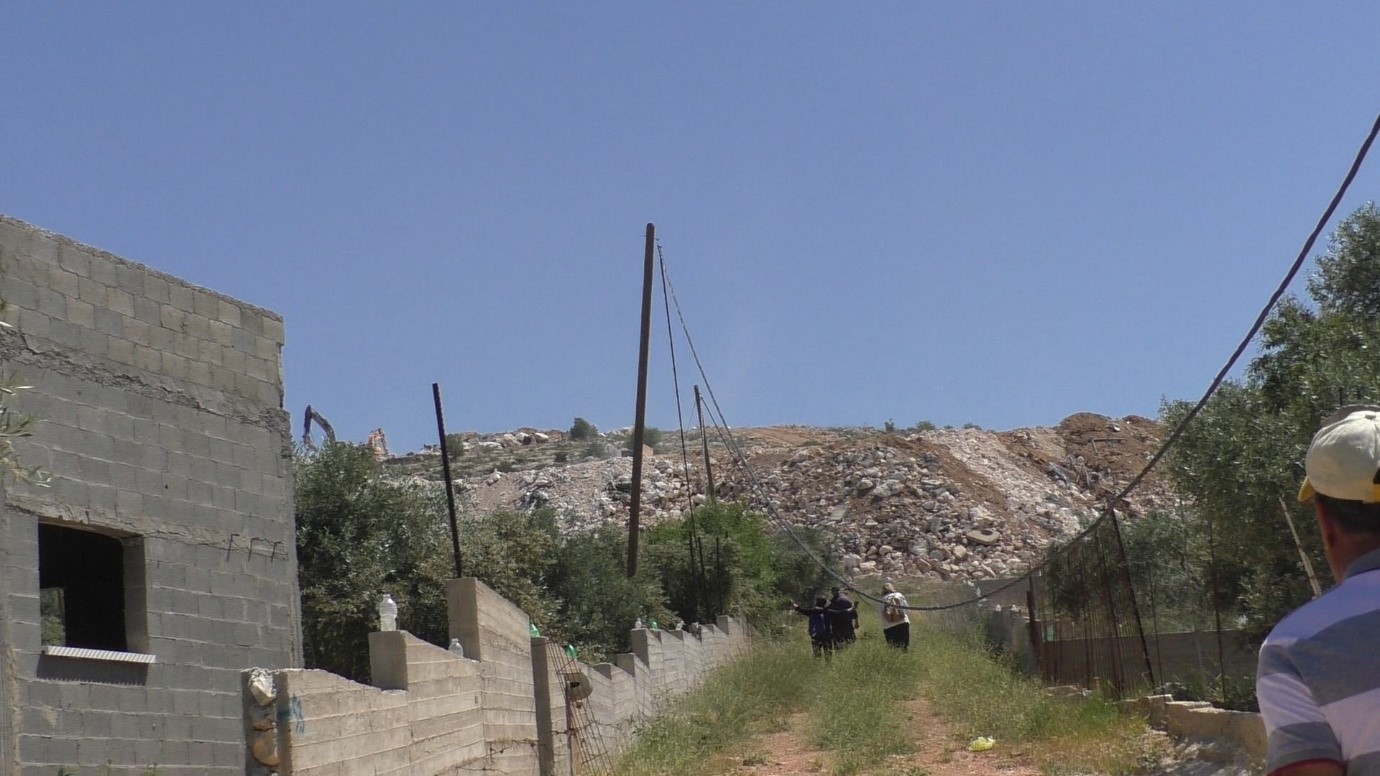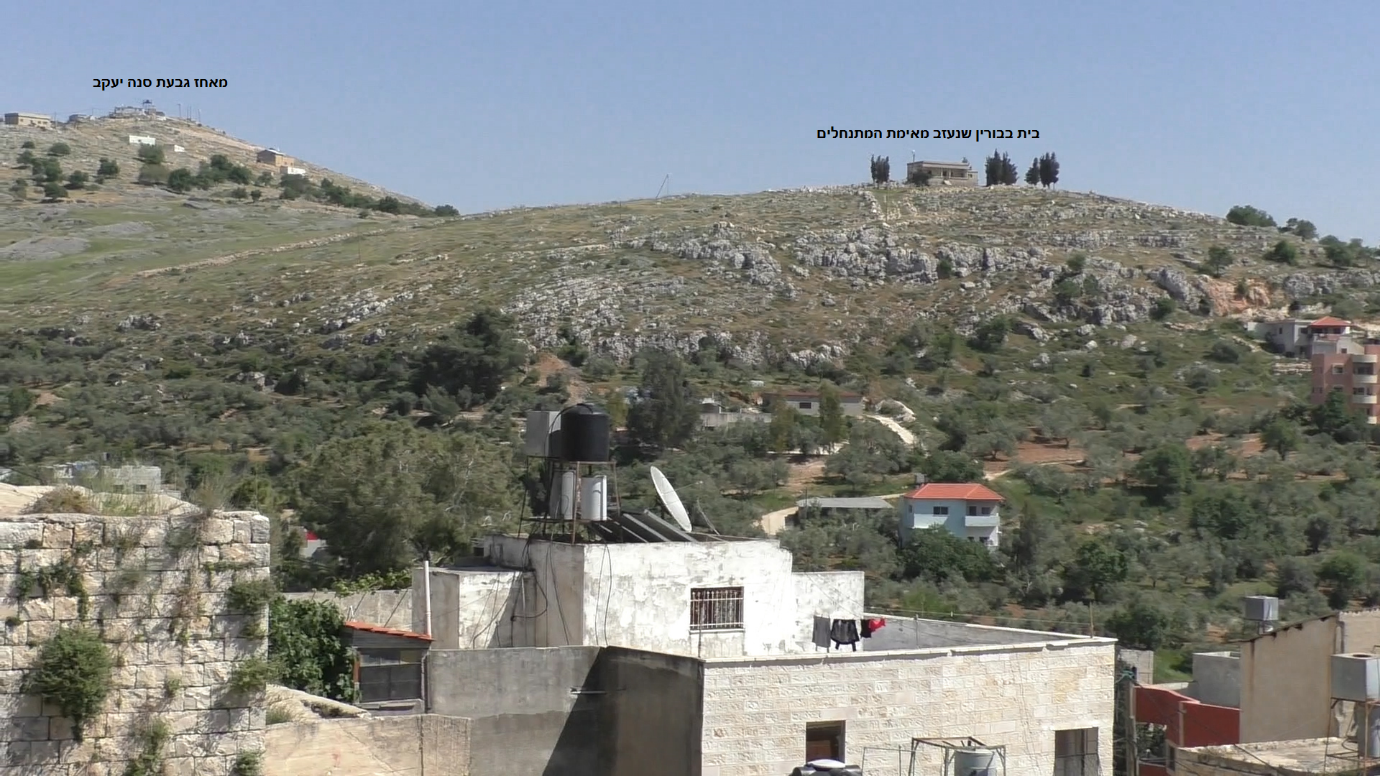Construction for the settlers, destruction for the Palestinians, Deir Balut, Burin

Deir Balut

photo: Nurit Poper 19/4/2017
New facts established on the ground: Infrastructure work for the new neighborhood proceeds rapidly. Buried in the process are olive groves, almond trees, electric poles, whatever’s there. Trucks unload sand and boulders. Some leave empty to bring a new load and others, already refilled, arrived to empty their contents. The result: the land is raised by 4-5 meters. During Passover week the work slowed, and now they’re energetically completing the planned destruction of fertile agricultural land which has been cultivated for generations by the local Palestinians. New facts established on the ground.
On highway 446, toward the Deir Balut junction. We’ve been visiting this area for a few months now, watching the vigorous construction underway at the Leshem settlement. The ridges along highway 46 are strewn with settlements: Fadu’el to the left, which took over the Deir Qle’a antiquities site and its olive trees, to the right Alei Zahav, and Leshem, a settlement that surrounded a different, magnificent antiquities site – Deir Sam’an, the identity of whose Palestinian owners is indisputable. The owners’ nightmare, that access to the site and the ancient olive trees that grow there will be blocked, is becoming a reality. South of the site a new neighborhood is being established. A large sign is visible from the road – “Harei Zahav” – the name of the neighborhood under construction.
We’re on the outskirts of Deir Balut, a flat, very fertile area. We’re on the way to a meeting with A., whose land borders the Leshem settlement. His countenance is bleak. His beloved fruit trees are being buried before his eyes along with the great investment he made to develop the land. Proudly but worried he showed us when we visited two months ago the young, well-tended grove about to be buried beneath the mound of earth and boulders.
E., an electrician providing services to the Deir Balut municipality, joined the meeting that had been arranged in advance. He speaks Hebrew. He worked in Israel for about five years until he was blacklisted. He doesn’t know why. He’s from a different village. Three or four months ago the municipality called him to inspect the damage to the electric poles.
He describes what he saw: Broken electric poles, leaning over or lying on the ground, some even buried, and the power lines hanging between the poles, still live. Very dangerous. He had to disconnect the current immediately. The area is still without electricity. He had to bring power from elsewhere.
In response to a question whether Israel can be sued for damages he said the municipality had complained to the Palestinian DCL in Qalqilya, in coordination with the Israeli DCL. They anticipate a trial. Will Israel compensate them for the damage it purposely caused?
During previous visits the landowner showed us documents from Ottoman times evidencing his family’s ownership of the land. We tried to determine whether Israel recognizes their ownership. We asked Dror Etkes to send us a Kav Kachol map showing the boundaries. The map shows the area included within the blue border, that is, the area categorized as state land. “Which state?” laughed the electrician when I told him. Attorneys are dealing with it. In despair, A. calls his attorney daily, who is unable to help. The hill rising before their eyes is coming closer. Soon it will bury all the trees that were planted there and will even invade the courtyard of the house A. built for his daughter and her family. Blue marks on the courtyard wall indicate the plans. On a previous visit he showed us he’d received a demolition order. They live in the shadow of fear and uncertainty.
We went to the area with the owner and the electrician, to see the damage to the power lines. Skeletons of buildings which can’t be completed stand along the sides of the road, and a line of leaning electric poles. A man who emerged from one of these buildings told us that his attempts to finish construction are failing. Security forces come immediately and stop the work.
A link to a video: https://www.youtube.com/watch?v=2hWzbBWLbnk&feature=youtube
Another resident, the father of five sons, who owns dozens of dunums in the area, sees his children’s future being buried along with the land which was to have ensured it. He’s very fearful of what will become of them and tries to keep them with him. The eldest is already 25 and the next is 22. If they have no land of their own to make a living from – they’ll begin to lose control. And then? He can’t continue. He stresses that he only wants to live quietly, doesn’t want to confront soldiers or settlers but he doesn’t want them to take his land.
One of the residents viewed the situation in a somewhat optimistic historical perspective: we’ve been subjugated in the past – Greeks, crusaders, Saladin, Turks, they all passed and the Israeli occupation will also pass and we’ll still be here.
Burin

photo: Nurit Poper 19.4.2017
Another visit to the house on the outskirts surrounded by hills teeming with cameras and settlers. The house is closed. Its heavy windows are shut. The door opens only after they saw us through the dense iron grating closing off the front terrace. The incidents of settlers coming to the house, mainly on Saturday, have become routine. The women who live here have already experienced harassment. It’s impossible not to feel the apprehensions of these brave women. One room was already set afire while the house was rented. The tenants, with a small child, left immediately. There’s a proposal to build a fence in order to enlarge the residents’ private area. But who will erect the fence? Where will the money come from?
From the heights of our friend S.’s terrace we viewed again the abandoned house that stands prominently on a hill very close to the one with the outpost of Sneh Ya’akov. Anyone approaching the house is immediately in danger of being attacked by the lawbreakers from the occupied hills.
S. sees things clearly. Together we considered how we could help. With respect to the idea that Israelis would be present in the building that settlers harass, as a shield against hoodlums protected by the law, he said that there would be a fight that would provide an excuse to arrest the Palestinian homeowners, not the attackers.
